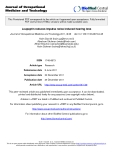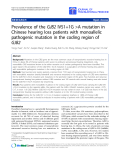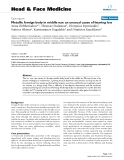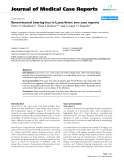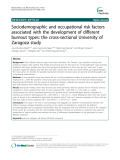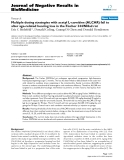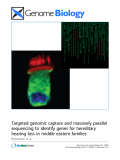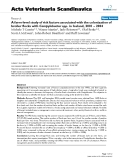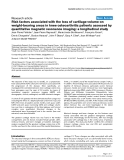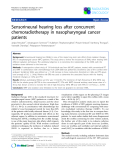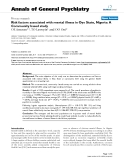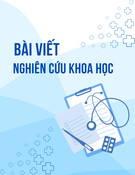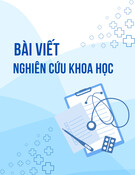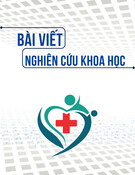
HUE JOURNAL OF MEDICINE AND PHARMACY ISSN 3030-4318; eISSN: 3030-4326 35
Hue Journal of Medicine and Pharmacy, Volume 14, No.6/2024
Clinical feature and risk factors associated with sensorineural hearing
loss in children at the Children’s Hospital 1: a preliminary study
Do Hoang Phong1, Luong Huu Dang1*, Pham Doan Tan Tai2, Nguyen Tuan Nhu2
(1) Department of Otolaryngology, Faculty of Medicine,
University of Medicine and Pharmacy at Ho Chi Minh City
(2) Department of Otorhinolaryngology, Children’s Hospital 1, Ho Chi Minh City
Abstract
Background: Hearing is a crucial sense and is particularly vital for children’s development, especially
those in the first five years of life. Congenital hearing loss leads to delayed language development, severely
impacting learning ability and the development of social skills, which cause consequences on children’s
psychophysiology. Early detection and knowing clearly about clinical features are very important, especially
for children with risk factors for hearing loss. Objectives: To determine the prevalence of factors associated
with sensorineural hearing loss among children the Children’s Hospital 1. Material and Methods: This study
included 72 pediatric patients diagnosed with sensorineural hearing loss at Children’s Hospital 1 from July
2022 to July 2023. Results: From July 2022 to July 2023, 72 children with a diagnosis of sensorineural hearing
loss at the Children’s Hospital 1 were included in this study. The degree of hearing loss most severe-to-
profound hearing loss (≥ 90 dB) was 54.3% as many as 46 children (63.9%) with asymmetrical hearing loss
in most of the subjects. Most of the children with bilateral congenital sensorineural hearing loss (SNHL) are
in the age > 5 years old (mean age: 5.8 years). Children with a history of neonatal resuscitation accounted
for the highest rate 59% within factors of risk factors for hearing loss. Conclusion: There was a delay in the
diagnosis of prelingual sensorineural hearing loss, with a high proportion of the severe-to-profound among
children presenting with a diagnosis. Enhancement of knowledge and development of hearing screening
programs for at-risk children towards a universal newborn hearing screening is urgently needed.
Keywords: hearing loss, sensorineural hearing loss, children.
Corresponding Author: Luong Huu Dang. Email: luonghuudang167@ump.edu.vn
Received: 31/1/2024; Accepted: 25/10/2024; Published: 25/12/2024
DOI: 10.34071/jmp.2024.6.4
1. INTRODUCTION
Hearing is a crucial sense and is particularly
vital for children’s development, especially those
in the first five years of life. Congenital hearing loss
leads to delayed language development, severely
impacting learning ability and the development
of social skills, which causes consequences on
children’s psychophysiology. In 2019, The Centers
for Disease Control and Prevention (CDC) conducted
a study in the United States to collect data from
states and territories, in which 98% of babies in
the USA were screened for newborn hearing loss.
The results showed that nearly 6000 babies born in
2019 had severe to profound hearing loss. The rate
of congential hearing loss of that study was 1.7 per
1000 children screened [1].
There was a delay in the diagnosis of prelingual
sensorineural hearing loss, with a high proportion of
the severe-to-profound among children presenting
with a diagnosis. Parents or guardians may not be
aware of the child’s hearing problems and may
only seek medical attention when the child displays
more apparent symptoms such as delayed speech or
slower mental development [1].
Some studies indicate that children with
early-onset hearing loss or congenital deafness if
appropriately intervened before 6 months of age, will
have language development levels equal to their peers
at the age of 5 (in the absence of other impairments).
Therefore, early identification and intervention of
this condition are important factors in the restoration
communication ability of the patients as well as their
language development. This is especially crucial
for children with delayed reception of auditory
stimuli - a group that is significantly affected without
early preventive planning, screening, appropriate
functional hearing assessment, and intervention.
2. MATERIALS AND METHODS
2.1. Study settings
This is a case series study which was done on 72
pediatric patients admitted to Children’s Hospital 1
from July 2022 to July 2023 with the diagnosis of
sensorineural hearing loss.





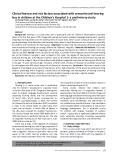
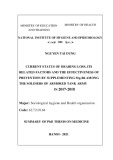
![Báo cáo hóa học: " An Auditory-Masking-Threshold-Based Noise Suppression Algorithm GMMSE-AMT[ERB] for Listeners with Sensorineural Hearing Loss"](https://cdn.tailieu.vn/images/document/thumbnail/2012/20120311/dauphong20/135x160/1687_6180_2005_678405_4795.jpg)
